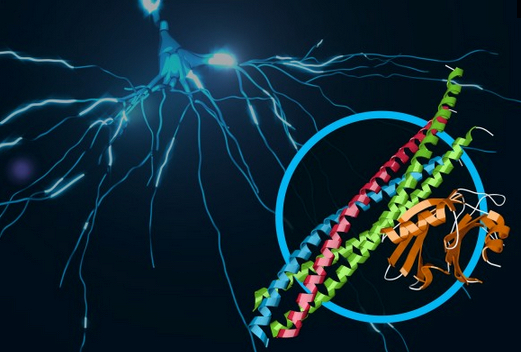Scientists discover atomic-resolution secret of high-speed brain signaling
August 17, 2015

This illustration shows a protein complex at work in brain signaling. Its structure, which contains joined protein complexes known as SNARE (shown in blue, red, and green) and synaptotagmin-1 (orange), is shown in the foreground. This complex is responsible for the calcium-triggered release of neurotransmitters from our brain’s nerve cells in a process called synaptic vesicle fusion. The background image shows electrical signals traveling through a neuron. (credit: SLAC National Accelerator Laboratory)
Stanford School of Medicine scientists have mapped the 3D atomic structure of a two-part protein complex that controls the release of signaling chemicals, called neurotransmitters, from brain cells in less than one-thousandth of a second.
The experiments were reported today (August 17) in the journal Nature. Performed at the Linac Coherent Light Source (LCLS) X-ray laser at the Department of Energy’s SLAC National Accelerator Laboratory, the experiments were built on decades of previous research at Stanford University, Stanford School of Medicine, and SLAC.
“This is a very important, exciting advance that may open up possibilities for targeting new drugs to control neurotransmitter release,” said Axel Brunger, the study’s principal investigator — a professor at Stanford School of Medicine and SLAC and a Howard Hughes Medical Institute investigator. “Many mental disorders, including depression, schizophrenia and anxiety, affect neurotransmitter systems.”
The two protein parts are known as neuronal SNAREs and synaptotagmin-1. “Both parts of this protein complex are essential,” Brunger said, “but until now it was unclear how its two pieces fit and work together.” Earlier X-ray studies, including experiments at SLAC’s Stanford Synchrotron Radiation Lightsource (SSRL) nearly two decades ago, shed light on the structure of the SNARE complex, a helical protein bundle found in yeasts and mammals.
SNAREs play a key role in the brain’s chemical signaling by joining, or “fusing,” little packets of neurotransmitters to the outer edges of neurons, where they are released and then dock with chemical receptors in another neuron to trigger a response.
Explains rapid triggering of brain signaling
In this latest research, the scientists found that when the SNAREs and synaptotagmin-1 join up, they act as an amplifier for a slight increase in calcium concentration, triggering a gunshot-like release of neurotransmitters from one neuron to another. They also learned that the proteins join together before they arrive at a neuron’s membrane, which helps to explain how they trigger brain signaling so rapidly.
The team speculates that several of the joined protein complexes may group together and simultaneously interact with the same vesicle to efficiently trigger neurotransmitter release, an exciting area for further studies. “The structure of the SNARE-synaptotagmin-1 complex is a milestone that the field has awaited for a long time, and it sets the framework for a better understanding of the system,” said James Rothman, a professor at Yale University who discovered the SNARE proteins and shared the 2013 Nobel Prize in Physiology or Medicine.
Thomas C. Südhof, a professor at the Stanford School of Medicine and Howard Hughes Medical Institute investigator who shared that 2013 Nobel Prize with Rothman, discovered synaptotagmin-1 and showed that it plays an important role as a calcium sensor and calcium-dependent trigger for neurotransmitter release.
“The new structure has identified unanticipated interfaces between synaptotagmin-1 and the neuronal SNARE complex that change how we think about their interaction by revealing, in atomic detail, exactly where they bind together,” Südhof said. “This is a new concept that goes much beyond previous general models of how synaptotagmin-1 functions.”
Using crystals, robotics and X-rays to advance neuroscience
To study the joined protein structure, researchers in Brunger’s laboratory at the Stanford School of Medicine found a way to grow crystals of the complex. They used a robotic system developed at SSRL to study the crystals at SLAC’s LCLS, an X-ray laser that is one of the brightest sources of X-rays on the planet. The researchers combined and analyzed hundreds of X-ray images from about 150 protein crystals to reveal the atomic-scale details of the joined structure.
According to SSRL’s Aina Cohen, who oversaw the development of the highly automated platform used for the neuroscience experiment, “This experiment was the first to use this robotic platform at LCLS to determine a previously unsolved structure of a large, challenging multi-protein complex.” The study was also supported by X-ray experiments at SSRL and at Argonne National Laboratory’s Advanced Photon Source.
Brunger said future studies will explore other protein interactions relevant to neurotransmitter release. “What we studied is only a subset,” he said. “There are many other factors interacting with this system and we want to know what these look like.”
Other contributing scientists were from Lawrence Berkeley National Laboratory. The research was supported by the Howard Hughes Medical Institute, the National Institutes of Health (NIH), the DOE Office Science, and the SSRL Structural Molecular Biology Program, which is also supported by the DOE Office of Science and the NIH’s National Institute of General Medical Sciences.
Abstract of Architecture of the synaptotagmin–SNARE machinery for neuronal exocytosis
Synaptotagmin-1 and neuronal SNARE proteins have central roles in evoked synchronous neurotransmitter release; however, it is unknown how they cooperate to trigger synaptic vesicle fusion. Here we report atomic-resolution crystal structures of Ca2+– and Mg2+-bound complexes between synaptotagmin-1 and the neuronal SNARE complex, one of which was determined with diffraction data from an X-ray free-electron laser, leading to an atomic-resolution structure with accurate rotamer assignments for many side chains. The structures reveal several interfaces, including a large, specific, Ca2+-independent and conserved interface. Tests of this interface by mutagenesis suggest that it is essential for Ca2+-triggered neurotransmitter release in mouse hippocampal neuronal synapses and for Ca2+-triggered vesicle fusion in a reconstituted system. We propose that this interface forms before Ca2+ triggering, moves en bloc as Ca2+ influx promotes the interactions between synaptotagmin-1 and the plasma membrane, and consequently remodels the membrane to promote fusion, possibly in conjunction with other interfaces.